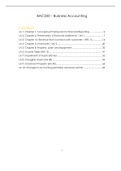Summary
BAC200: Summary of Semester 1
- Course
- Institution
- Book
This document contains a summary from work done from the Introduction to IFRS 8th edition textbook by Koppeschaar et al as well as lecture notes and examples. It encompasses Learning Area 1 - 10
[Show more]






